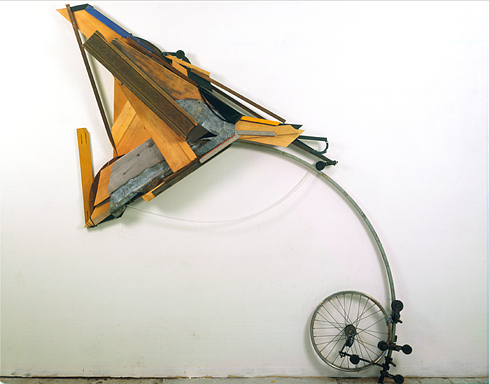

Job # 757, mixed media, 81 x 81 x 9 inches.
D I S C A R D E D
Modern anthropologists and urban archaeologists get a sense of a culture from what it wastes or disregards. Ours is a consumer society filled with mechanical obsolescence. In less than a century, we have accepted mass media, mass transportation, electronics, synthetics and new sciences such as human ecology, biotechnology and plasma physics. We have a lot of information, a lot of stuff and a lot of leftovers.
Found matter first appears in Western art between 1912 and 1914. Picasso and Braque used original textures – newspaper, fabric and wallpaper – in their Cubist collages. Duchamp exhibited “Ready-Mades,” utilitarian objects as art. After World War I, Schwitters, another proponent of Dadaism, incorporated machine-printed packaging, detritus, rubbish and crude, worn-out materials into his paintings and assemblages. The Surrealists later called this “les moyens pauvres,” or poor means. In subsequent decades, others, including Cornell, Calder, Nevelson, Simon Rodia and Hannelore Baron would make art of found objects.
In the sixties, following the overt expression of emotion and gesture in Action Painting, artists such as Chamberlain, Keinholz, Bruce Conner, Marisol, Rauschenberg and Johns confronted pop culture by incorporating its ephemera in their work. “Les Affichistes,” the artists who randomly tore down street posters, “decollaged” (unpasted) and then repasted them, were exhibited as part of the “Nouveaux Réalistes”. The experiments of Arte Povera, Eva Hesse and others, which juxtaposed and fused unexpected materials, again suggested the use if “extra-artistic” or humble means.
Just as we somehow absorbed the changes of the 20th century, these ideas and innovations seeped into liberated aesthetic awareness. Today, the list of artists who recycle and reuse forgotten or second-hand matter has grown substantially.
As an artist myself, I use found materials because of their spirit, their economy and their lack of pretense. My mother once told me that you can’t make a silk purse out of a sow’s ear. For me, this was good enough reason to try.
As a curator, I have assembled eleven New York artists who have incorporated discarded and found matter in their work for at least ten years. Like alchemists, they create things of great value and unusual beauty from unassuming materials. They also have the rare ability to set aside convention and yet they communicate clearly. Each artist balances abstract thought with the reality and tangibility of the found object. They all make order out of chaos.
As a group, these artists are far from single-minded. Each has a particular point of view. Each has a distinct direction. What each artist chooses to include in the making of a piece is crucial, even though the elements may be transformed. An individual sense of form and personal aesthetic is shaped by these things that have served their purpose and have been rejected. Through this method of selection, a wide spectrum of thought, feeling and comment on our culture is provoked.
New York City abounds in tossed-out artifacts. The materials found in this densely populated urban environment tend to be similar in nature and mostly manufactured, industrial or fragments of building construction and renovation. The artists in this show use what is out there. They take the overlooked and the immediately obsolete and redefine it.
This use of cultural evidence adds a sense of reality and richness of detail to their work. Inherent in this process is the desire, whether conscious or subliminal, to document our surroundings, our community and our lives.
Found matter can serve as a multifaceted palette. Objects echo their history in the way that pentimento, the appearance of underpainting on the surface of a canvas, occurs. As residues of life, discarded elements have participated and interacted with people. Their links to humanity are emphasized in the works of artists included in this exhibition, especially those of Mel Edwards, Bob Smith, David Hammons, Kalmia and Allan Wexler. Existing objects are chosen for their intrinsic or potential beauty by Donald Lipski, and for their genuineness by Ernest Acker-Gherardino. When refuse is recycled by Mierle Laderman Ukeles, it brings attention to the enormous waste in our socioeconomic environment. Finally, in the work of Mattie Berhang, Richard Tuttle and Judy Pfaff, abandoned materials function more obviously as formal components.
The use of remnants, fragments, the thrown away and the left over is a common denominator. The reassessments and diverse applications of these elements create a myriad of meanings and emotions.
Joyce Abrams
© 1991. All rights reserved.
Joyce Abrams is an artist who lives and works in New York City. She uses discarded elements in her own work.
This essay was written for the catalogue for the exhibition, “DISCARDED.” It was curated by the author and shown at the Rockland Center for the Arts from October through November 1991.
For further information about the artist and her work, you may contact: Raphael Collazo Foundation, 2345 Broadway, Suite 638, New York, New York 10024. Tel: 212.787.0500. E-mail: director@collazo.org.